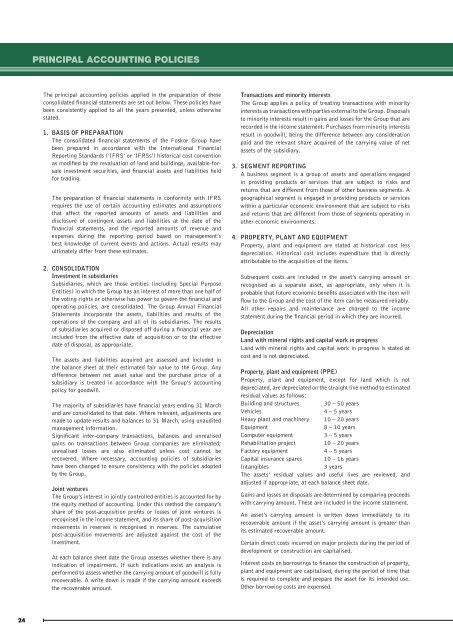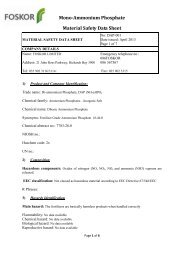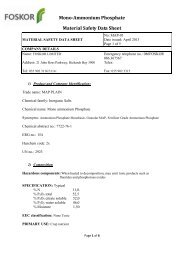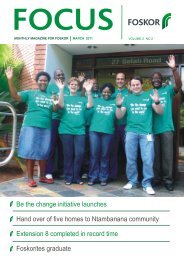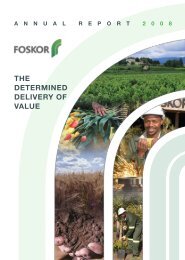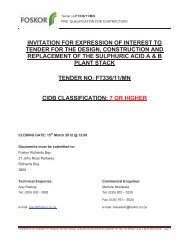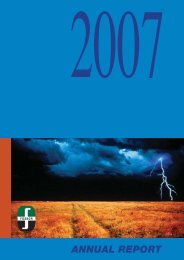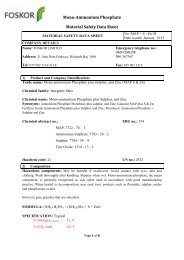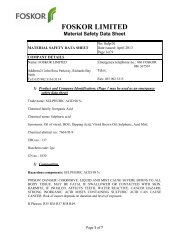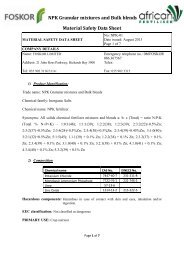Download Annual Report 2006 - Foskor
Download Annual Report 2006 - Foskor
Download Annual Report 2006 - Foskor
You also want an ePaper? Increase the reach of your titles
YUMPU automatically turns print PDFs into web optimized ePapers that Google loves.
PRINCIPAL ACCOUNTING POLICIESThe principal accounting policies applied in the preparation of theseconsolidated financial statements are set out below. These policies havebeen consistently applied to all the years presented, unless otherwisestated.1. BASIS OF PREPARATIONThe consolidated financial statements of the <strong>Foskor</strong> Group havebeen prepared in accordance with the International Financial<strong>Report</strong>ing Standards (‘IFRS’ or ‘IFRSs’) historical cost conventionas modified by the revaluation of land and buildings, available-forsaleinvestment securities, and financial assets and liabilities heldfor trading.The preparation of financial statements in conformity with IFRSrequires the use of certain accounting estimates and assumptionsthat affect the reported amounts of assets and liabilities anddisclosure of contingent assets and liabilities at the date of thefinancial statements, and the reported amounts of revenue andexpenses during the reporting period based on management’sbest knowledge of current events and actions. Actual results mayultimately differ from these estimates.2. CONSOLIDATIONInvestment in subsidiariesSubsidiaries, which are those entities (including Special PurposeEntities) in which the Group has an interest of more than one half ofthe voting rights or otherwise has power to govern the financial andoperating policies, are consolidated. The Group <strong>Annual</strong> FinancialStatements incorporate the assets, liabilities and results of theoperations of the company and all of its subsidiaries. The resultsof subsidiaries acquired or disposed off during a financial year areincluded from the effective date of acquisition or to the effectivedate of disposal, as appropriate.The assets and liabilities acquired are assessed and included inthe balance sheet at their estimated fair value to the Group. Anydifference between net asset value and the purchase price of asubsidiary is treated in accordance with the Group’s accountingpolicy for goodwill.The majority of subsidiaries have financial years ending 31 Marchand are consolidated to that date. Where relevant, adjustments aremade to update results and balances to 31 March, using unauditedmanagement information.Significant inter-company transactions, balances and unrealisedgains on transactions between Group companies are eliminated;unrealised losses are also eliminated unless cost cannot berecovered. Where necessary, accounting policies of subsidiarieshave been changed to ensure consistency with the policies adoptedby the Group.Joint venturesThe Group’s interest in jointly controlled entities is accounted for bythe equity method of accounting. Under this method the company’sshare of the post-acquisition profits or losses of joint ventures isrecognised in the income statement, and its share of post-acquisitionmovements in reserves is recognised in reserves. The cumulativepost-acquisition movements are adjusted against the cost of theinvestment.At each balance sheet date the Group assesses whether there is anyindication of impairment. If such indications exist an analysis isperformed to assess whether the carrying amount of goodwill is fullyrecoverable. A write down is made if the carrying amount exceedsthe recoverable amount.Transactions and minority interestsThe Group applies a policy of treating transactions with minorityinterests as transactions with parties external to the Group. Disposalsto minority interests result in gains and losses for the Group that arerecorded in the income statement. Purchases from minority interestsresult in goodwill, being the difference between any considerationpaid and the relevant share acquired of the carrying value of netassets of the subsidiary.3. SEGMENT REPORTINGA business segment is a group of assets and operations engagedin providing products or services that are subject to risks andreturns that are different from those of other business segments. Ageographical segment is engaged in providing products or serviceswithin a particular economic environment that are subject to risksand returns that are different from those of segments operating inother economic environments.4. PROPERTY, PLANT AND EQUIPMENTProperty, plant and equipment are stated at historical cost lessdepreciation. Historical cost includes expenditure that is directlyattributable to the acquisition of the items.Subsequent costs are included in the asset’s carrying amount orrecognised as a separate asset, as appropriate, only when it isprobable that future economic benefits associated with the item willflow to the Group and the cost of the item can be measured reliably.All other repairs and maintenance are charged to the incomestatement during the financial period in which they are incurred.DepreciationLand with mineral rights and capital work in progressLand with mineral rights and capital work in progress is stated atcost and is not depreciated.Property, plant and equipment (PPE)Property, plant and equipment, except for land which is notdepreciated, are depreciated on the straight line method to estimatedresidual values as follows:Building and structures 30 – 50 yearsVehicles4 – 5 yearsHeavy plant and machinery 10 – 20 yearsEquipment8 – 10 yearsComputer equipment3 – 5 yearsRehabilitation project 10 – 20 yearsFactory equipment4 – 5 yearsCapital insurance spares 10 – 16 yearsIntangibles3 yearsThe assets’ residual values and useful lives are reviewed, andadjusted if appropriate, at each balance sheet date.Gains and losses on disposals are determined by comparing proceedswith carrying amount. These are included in the income statement.An asset’s carrying amount is written down immediately to itsrecoverable amount if the asset’s carrying amount is greater thanits estimated recoverable amount.Certain direct costs incurred on major projects during the period ofdevelopment or construction are capitalised.Interest costs on borrowings to finance the construction of property,plant and equipment are capitalised, during the period of time thatis required to complete and prepare the asset for its intended use.Other borrowing costs are expensed.24


